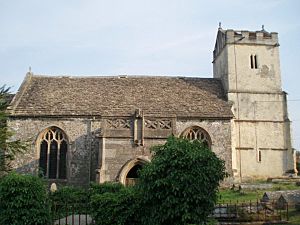St James' Church, Charfield facts for kids
Quick facts for kids St James' Church, Charfield |
|
|---|---|

St James' Church, Charfield, from the north
|
|
| Lua error in Module:Location_map at line 420: attempt to index field 'wikibase' (a nil value). | |
| OS grid reference | ST 718 911 |
| Location | Charfield, Gloucestershire |
| Country | England |
| Denomination | Anglican |
| Website | [1] |
| Architecture | |
| Functional status | Redundant |
| Heritage designation | Grade I |
| Designated | 30 March 1960 |
| Architectural type | Church |
| Style | Gothic |
| Groundbreaking | 13th century |
| Completed | 15th century |
| Specifications | |
| Materials | Stone with Cotswold stone slate roofs |
St James' Church is a very old and special church located in the village of Charfield, Gloucestershire, England. It's an Anglican church, which means it belongs to the Church of England. This church is so important that it's looked after by a group called The Churches Conservation Trust. It's also listed as a Grade I building, which is the highest level of protection for historic places in England. You can find it on a steep hill, looking out over a beautiful valley.
Contents
History of St James' Church
This church first started being built way back in the 13th century. That's over 700 years ago! Most of the church was rebuilt in the 15th century. The money for this big project came from the local wool trade, which was very important back then.
During the 18th century, the wool industry moved down into the valley. This left the church feeling a bit isolated up on the hill. The church was carefully repaired during the 1970s to keep it in good condition.
Understanding the Church's Design
St James' Church is built from stone rubble, which means rough, uneven stones. Its roofs are made from Cotswold stone slate, a type of stone found in the area.
Parts of the Church Building
The church has a main area called the nave. It also has a south aisle and a north porch, which is like an entrance area. There's a chancel at the east end, where the altar is. At the west end, there's a tall tower.
The tower has four sections and strong diagonal buttresses to support it. In the top section, there are openings for the bells. The top edge of the tower is battlemented, meaning it has a shape like the top of a castle wall. The tower also has a special saddleback roof, which looks like a saddle.
On the north side of the nave, there are two windows with three sections each. Between these windows is the porch. This porch has a fancy pierced parapet and a small niche where a statue might have once stood.
The chancel has two three-section windows on its north wall. There's also a large three-section window at the east end. A priest's door, which is now blocked up, is also in the chancel. Along the wall of the south aisle, there are three more three-section windows.
Inside the Church
Inside the church, between the nave and the south aisle, there's an arcade. This is a row of three arches supported by octagonal piers, which are like thick columns.
In the nave, you can find a squint. This is a small opening that allowed people to see the altar, even if they were in a side part of the church.
The chancel has a trefoil-headed piscina. A piscina is a basin used for washing sacred vessels. It also has the remains of heads from old image niches. You can also see memorials inside the church from 1717 and 1756.
Exploring the Churchyard
The churchyard around St James' Church is also very interesting. It contains five separate stone chest tombs. There's also a group of four chest tombs together. All of these tombs are very old, dating from the 18th century. They are made from limestone ashlar, which is finely cut stone. The group of four tombs are surrounded by cast iron railings.
The churchyard also has a special memorial. It remembers the 15 people who sadly lost their lives in the Charfield railway disaster in 1928. You can also find the war grave of an airman who served in World War II.
More to Explore
See also
 In Spanish: Iglesia de San James (Charfield) para niños
In Spanish: Iglesia de San James (Charfield) para niños

